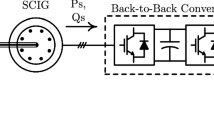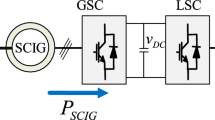Abstract
Under the trends to using renewable energy sources as alternatives to the traditional ones, it is important to contribute to the fast growing development of these sources by using powerful soft computing methods. In this context, this paper introduces a novel structure to optimize and control the energy produced from a variable speed wind turbine which is based on a squirrel cage induction generator (SCIG) and connected to the grid. The optimization strategy of the harvested power from the wind is realized by a maximum power point tracking (MPPT) algorithm based on fuzzy logic, and the control strategy of the generator is implemented by means of an internal model (IM) controller. Three IM controllers are incorporated in the vector control technique, as an alternative to the proportional integral (PI) controller, to implement the proposed optimization strategy. The MPPT in conjunction with the IM controller is proposed as an alternative to the traditional tip speed ratio (TSR) technique, to avoid any disturbance such as wind speed measurement and wind turbine (WT) characteristic uncertainties. Based on the simulation results of a six KW-WECS model in Matlab/Simulink, the presented control system topology is reliable and keeps the system operation around the desired response.
Similar content being viewed by others
Abbreviations
- A :
-
Swept area of the WT
- B :
-
Gearbox ratio
- i :
-
Current
- J t :
-
The equivalent inertia of the WT and the generator
- L :
-
Inductance
- p :
-
Number of pole pair
- R :
-
Rotor WT radius
- r :
-
Resistance
- s :
-
Laplace operator
- ν :
-
Voltage
- z :
-
Delay operator
- Φ:
-
Flux linkage
- ω :
-
Synchronous speed
- Ω:
-
Rotational speed
- θ :
-
Angle position
- β :
-
Pitch angle
- λ :
-
Tip speed ratio
- *:
-
Set point
- opt:
-
Optimal value
- a, b and c :
-
Three phase components
- d :
-
d-axis
- DC:
-
Direct current
- e:
-
Electrical
- g:
-
Generator
- gr:
-
Grid
- m:
-
Mutual
- q:
-
q-axis
- r:
-
Rotor
- s:
-
Stator
References
The Ministry of Energy. Mines,Water and Environment of Morocco (MEMWE) (2016). Press Release. http://www.mem.gov.ma/Site-Pages/Activites2016/Ac21Janv16.aspx, 2016-12-31
Munteanu I, Bratcu A I, Ceanga E. Wind turbulence used as searching signal for MPPT in variable-speed wind energy conversion systems. Renewable Energy, 2009, 34(1): 322–327
Narayana M, Putrus G A, Jovanovic M, Leung P S, McDonald S. Generic maximum power point tracking controller for small-scale wind turbines. Renewable Energy, 2012, 44: 72–79
Eltamaly A M, Farh H M. Maximum power extraction from wind energy system based on fuzzy logic control. Electric Power Systems Research, 2013, 97: 144–150
Zhao H, Wu Q, Rasmussen C N, Blanke M. Adaptive speed control of a small wind energy conversion system for maximum power point tracking. IEEE Transactions on Energy Conversion, 2014, 29(3): 576–584
Yaakoubi A E, Asselman A, Djebli A, Aroudam E H. A MPPT strategy based on fuzzy control for a wind energy conversion system. Procedia Technology, 2016, 22: 697–704
Senjyu T, Ochi Y, Kikunaga Y, Tokudome M, Yona A, Muhando E B, Urasaki N, Funabashi T. Sensor-less maximum power point tracking control for wind generation system with squirrel cage induction generator. Renewable Energy, 2009, 34(4): 994–999
Meharrar A, Tioursi M, Hatti M, Boudghène Stambouli A. A variable speed wind generator maximum power tracking based on adaptative neuro-fuzzy inference system. Expert Systems with Applications, 2011, 38(6): 7659–7664
Hong C M, Chen C H, Tu C S. Maximum power point trackingbased control algorithm for PMSG wind generation system without mechanical sensors. Energy Conversion and Management, 2013, 69: 58–67
Kim K H, Van T L, Lee D C, Song S H, Kim E H. Maximum output power tracking control in variable-speed wind turbine systems considering rotor inertial power. IEEE Transactions on Industrial Electronics, 2013, 60(8): 3207–3217
Elnaggar M, Abdel Fattah H A, Elshafei A L. Maximum power tracking in WECS (Wind energy conversion systems) via numerical and stochastic approaches. Energy, 2014, 74: 651–661
Belmokhtar K, Doumbia M L, Agbossou K. Novel fuzzy logic based sensorless maximum power point tracking strategy for wind turbine systems driven DFIG (doubly-fed induction generator). Energy, 2014, 76: 679–693
Liu P, Yang W T, Yang C E, Hsu C L. Sensorless wind energy conversion system maximum power point tracking using Takagi–Sugeno fuzzy cerebellar model articulation control. Applied Soft Computing, 2015, 29: 450–460
Huang C, Li F, Jin Z. Maximum power point tracking strategy for large-scale wind generation systems considering wind turbine dynamics. IEEE Transactions on Industrial Electronics, 2015, 62(4): 2530–2539
Abdullah M A, Yatim A H M, Tan C W, Saidur R. A review of maximum power point tracking algorithms for wind energy systems. Renewable & Sustainable Energy Reviews, 2012, 16(5): 3220–3227
Eltamaly A M, Alolah A I, Farh H M. Maximum power extraction from utility-interfaced wind turbines. 2016-06, http://www.intechopen.com/books/new-developments-in-renewable-energy/maximum-power-extraction-from-utility-interfaced-wind-turbines
Nasiri M, Milimonfared J, Fathi S H. Modeling, analysis and comparison of TSR and OTC methods for MPPT and power smoothing in permanent magnet synchronous generator-based wind turbines. Energy Conversion and Management, 2014, 86: 892–900
Daili Y, Gaubert J P, Rahmani L. Implementation of a new maximum power point tracking control strategy for small wind energy conversion systems without mechanical sensors. Energy Conversion and Management, 2015, 97: 298–306
Dalala Z M, Zahid Z H, Lai J S. New overall control strategy for small-scale WECS in MPPT and stall regions with mode transfer control. IEEE Transactions on Energy Conversion, 2013, 28(4): 1082–1092
Uddin M N, Patel N. Maximum power point tracking control of IPMSG incorporating loss minimization and speed sensorless schemes for wind energy system. IEEE Transactions on Industry Applications, 2016, 52(2): 1902–1912
Hussain J, Mishra M K. Adaptive maximum power point tracking control algorithm for wind energy conversion systems. IEEE Transactions on Energy Conversion, 2016, 31(2): 697–705
Zeng Q, Chang L, Shao R. Fuzzy-logic-based maximum power point tracking strategy for Pmsg variable-speed wind turbine generation systems. 2016-06, http://xueshu.baidu.com/s?wd=paperuri%3A%28bafbd7c8551c25f1d05118a80fedb7a2%29&filter=sc_long_sign&tn=SE_xueshusource_2kduw22v&sc_vurl=http%3A%2F%2Fieeexplore.ieee.org%2Fxpl%2FabstractKeywords.jsp%3Freload%3Dtrue%26arnumber%3D4564566&ie=utf-8&sc_us=16994133383635512793
Chekkal S, Lahaçani N A, Aouzellag D, Ghedamsi K. Fuzzy logic control strategy of wind generator based on the dual-stator induction generator. Electrical Power and Energy Systems, 2014, 59: 166–175
Belmokhtar K, Doumbia M L, Agbossou K. Novel fuzzy logic based sensorless maximum power point tracking strategy for wind turbine systems driven DFIG (doubly-fed induction generator). Energy, 2014, 76: 679–693
Lee J, Kim Y S. Sensorless fuzzy-logic-based maximum power point tracking control for a small-scale wind power generation systems with a switched-mode rectifier. IET Renewable Power Generation, 2016, 10(2): 194–202
Domínguez-García J L, Gomis-Bellmunt O, Trilla-Romero L, Junyent-Ferré A. Indirect vector control of a squirrel cage induction generator wind turbine. Computers & Mathematics with Applications (Oxford, England), 2012, 64(2): 102–114
Boukhezzar B, Siguerdidjane H. Nonlinear control with wind estimation of a DFIG variable speed wind turbine for power capture optimization. Energy Conversion and Management, 2009, 50(4): 885–892
Chen Z, Guerrero JM, Blaabjerg F. A review of the state of the art of power electronics for wind turbines. IEEE Transactions on Power Electronics, 2009, 24(8): 1859–1875
Tamaarat A, Benakcha A. Performance of PI controller for control of active and reactive power in DFIG operating in a grid-connected variable speed wind energy conversion system. Frontiers in Energy, 2014, 8(3): 371–378
Duong M Q, Grimaccia F, Leva S, Mussetta M, Ogliari E. Pitch angle control using hybrid controller for all operating regions of SCIG wind turbine system. Renewable Energy, 2014, 70: 197–203
Duong M Q, Grimaccia F, Leva S, Mussetta M, Le K H. Improving transient stability in a grid-connected squirrel-cage induction generator wind turbine system using a fuzzy logic controller. Energies, 2015, 8(7): 6328–6349
Zadeh L A. Fuzzy sets. Information and Control, 1965, 8(3): 338–353
Anaya-Lara O, Campos-Gaona D, Moreno-Goytia E, Adam G. Offshore Wind Energy Generation: Control, Protrction, and Integration to Electrical Systems. Hoboke: Wiley-Blackwell, 2014
Author information
Authors and Affiliations
Corresponding author
Rights and permissions
About this article
Cite this article
El Yaakoubi, A., Attari, K., Asselman, A. et al. Novel power capture optimization based sensorless maximum power point tracking strategy and internal model controller for wind turbines systems driven SCIG. Front. Energy 13, 742–756 (2019). https://doi.org/10.1007/s11708-017-0462-x
Received:
Accepted:
Published:
Issue Date:
DOI: https://doi.org/10.1007/s11708-017-0462-x




